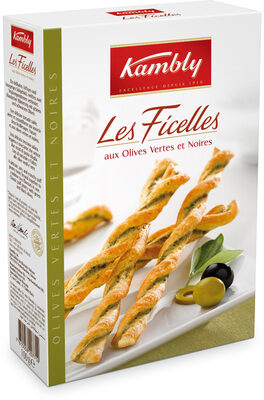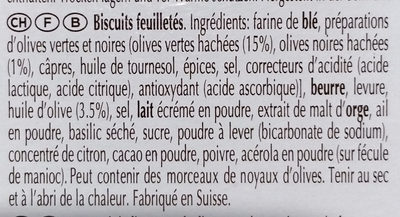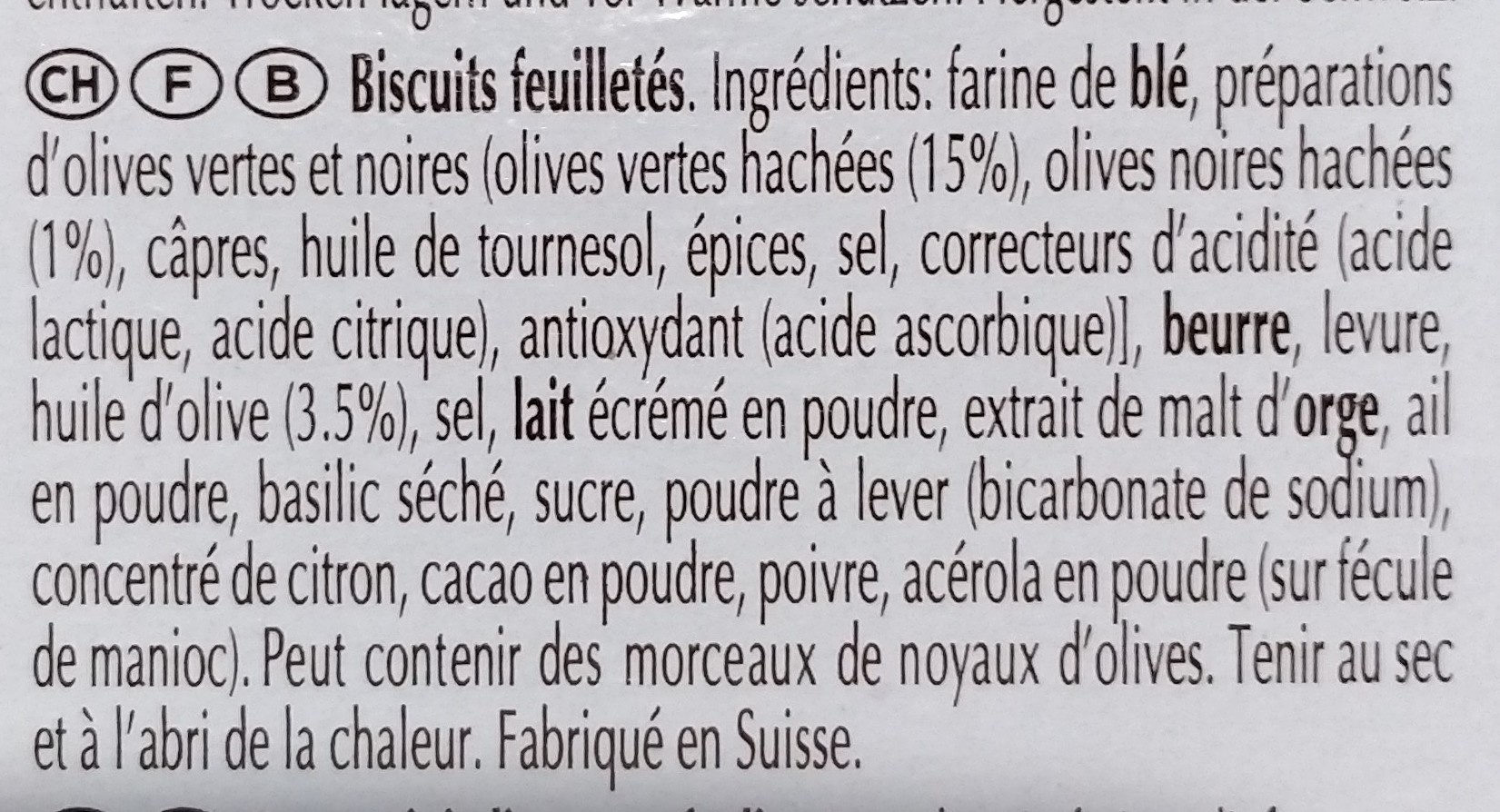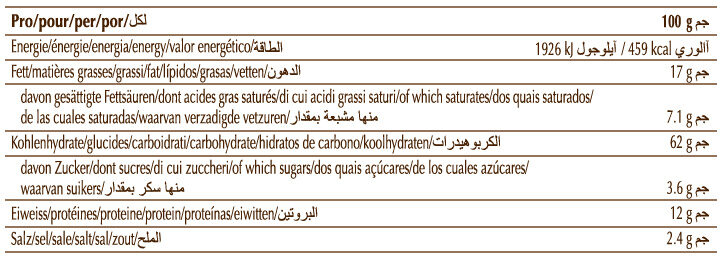Help us make food transparency the norm!
As a non-profit organization, we depend on your donations to continue informing consumers around the world about what they eat.
The food revolution starts with you!
Ficelles Olives Vertes et Noires - Kambly - 100 g
Ficelles Olives Vertes et Noires - Kambly - 100 g
This product page is not complete. You can help to complete it by editing it and adding more data from the photos we have, or by taking more photos using the app for Android or iPhone/iPad. Thank you!
×
Some of the data for this product has been provided directly by the manufacturer KAMBLY FRANCE.
Barcode: 7610058207714 (EAN / EAN-13)
Common name: Biscuits feuilletés aux olives vertes et noires
Quantity: 100 g
Packaging: Plastic, Cardboard, Film
Brands: Kambly
Categories: Snacks, Salty snacks, Appetizers, Crackers, fr:Biscuits apéritifs sans fromage, fr:Ficelle, fr:Flûte droite, fr:Flûte droite amélioriée, fr:Olive Verte et Noire
Labels, certifications, awards: No preservatives, fr:Sans arômes ni colorants artificiels
Origin of the product and/or its ingredients: Suisse
Manufacturing or processing places: CH-3555 Trubschachen, UE, Suisse
Link to the product page on the official site of the producer: https://kambly.fr/product/les-ficelles-a...
Stores: Cora, Carrefour, Géant, Auchan, Franprix, Leclerc, Intermarché, Migros, Match, Système U, Casino, U enseigne, Diapar, colryut, segurel
Countries where sold: France
Matching with your preferences
Health
Ingredients
-
29 ingredients
French: Farine de BLE, preparations d'olives vertes et noires (olives vertes hachees (15%), olives noires hachees (1%), capres, huile de tournesol, epices, sel, correcteurs d'acidite (acide lactique, acide citrique), antioxydant (acide ascorbique)), BEURRE, levure, huile d'olive (3.5%), sel, LAIT ecreme en poudre, extrait de malt d'orge, ail en poudre, basilic seche, sucre, poudre a lever (bicarbonate de sodium), concentre de citron, cacao en poudre, poivre, acerola en poudre (sur fecule de manioc). peut contenir des morceaux de noyaux d'olives .Allergens: Gluten, Milk
Food processing
-
Processed foods
Elements that indicate the product is in the 3 - Processed foods group:
- Category: Salty snacks
- Ingredient: Butter
- Ingredient: Salt
- Ingredient: Sugar
- Ingredient: Vegetable oil
- Ingredient: Milk powder
Food products are classified into 4 groups according to their degree of processing:
- Unprocessed or minimally processed foods
- Processed culinary ingredients
- Processed foods
- Ultra processed foods
The determination of the group is based on the category of the product and on the ingredients it contains.
Additives
-
E270 - Lactic acid
Lactic acid: Lactic acid is an organic compound with the formula CH3CH-OH-COOH. In its solid state, it is white and water-soluble. In its liquid state, it is colorless. It is produced both naturally and synthetically. With a hydroxyl group adjacent to the carboxyl group, lactic acid is classified as an alpha-hydroxy acid -AHA-. In the form of its conjugate base called lactate, it plays a role in several biochemical processes. In solution, it can ionize a proton from the carboxyl group, producing the lactate ion CH3CH-OH-CO−2. Compared to acetic acid, its pKa is 1 unit less, meaning lactic acid deprotonates ten times more easily than acetic acid does. This higher acidity is the consequence of the intramolecular hydrogen bonding between the α-hydroxyl and the carboxylate group. Lactic acid is chiral, consisting of two optical isomers. One is known as L--+--lactic acid or -S--lactic acid and the other, its mirror image, is D--−--lactic acid or -R--lactic acid. A mixture of the two in equal amounts is called DL-lactic acid, or racemic lactic acid. Lactic acid is hygroscopic. DL-lactic acid is miscible with water and with ethanol above its melting point which is around 17 or 18 °C. D-lactic acid and L-lactic acid have a higher melting point. In animals, L-lactate is constantly produced from pyruvate via the enzyme lactate dehydrogenase -LDH- in a process of fermentation during normal metabolism and exercise. It does not increase in concentration until the rate of lactate production exceeds the rate of lactate removal, which is governed by a number of factors, including monocarboxylate transporters, concentration and isoform of LDH, and oxidative capacity of tissues. The concentration of blood lactate is usually 1–2 mM at rest, but can rise to over 20 mM during intense exertion and as high as 25 mM afterward. In addition to other biological roles, L-lactic acid is the primary endogenous agonist of hydroxycarboxylic acid receptor 1 -HCA1-, which is a Gi/o-coupled G protein-coupled receptor -GPCR-.In industry, lactic acid fermentation is performed by lactic acid bacteria, which convert simple carbohydrates such as glucose, sucrose, or galactose to lactic acid. These bacteria can also grow in the mouth; the acid they produce is responsible for the tooth decay known as caries. In medicine, lactate is one of the main components of lactated Ringer's solution and Hartmann's solution. These intravenous fluids consist of sodium and potassium cations along with lactate and chloride anions in solution with distilled water, generally in concentrations isotonic with human blood. It is most commonly used for fluid resuscitation after blood loss due to trauma, surgery, or burns.Source: Wikipedia
-
E330 - Citric acid
Citric acid is a natural organic acid found in citrus fruits such as lemons, oranges, and limes.
It is widely used in the food industry as a flavor enhancer, acidulant, and preservative due to its tart and refreshing taste.
Citric acid is safe for consumption when used in moderation and is considered a generally recognized as safe (GRAS) food additive by regulatory agencies worldwide.
-
E500 - Sodium carbonates
Sodium carbonates (E500) are compounds commonly used in food preparation as leavening agents, helping baked goods rise by releasing carbon dioxide when they interact with acids.
Often found in baking soda, they regulate the pH of food, preventing it from becoming too acidic or too alkaline. In the culinary world, sodium carbonates can also enhance the texture and structure of foods, such as noodles, by modifying the gluten network.
Generally recognized as safe, sodium carbonates are non-toxic when consumed in typical amounts found in food.
-
E500ii - Sodium hydrogen carbonate
Sodium hydrogen carbonate, also known as E500ii, is a food additive commonly used as a leavening agent.
When added to recipes, it releases carbon dioxide gas upon exposure to heat or acids, causing dough to rise and resulting in a light, fluffy texture in baked goods.
It is generally recognized as safe (GRAS) by regulatory authorities when used in appropriate quantities and poses no significant health risks when consumed in typical food applications.
Ingredients analysis
-
Palm oil free
No ingredients containing palm oil detected
Unrecognized ingredients: fr:preparations-d-olives-vertes-et-noires, fr:sur-fecule-de-maniocSome ingredients could not be recognized.
We need your help!
You can help us recognize more ingredients and better analyze the list of ingredients for this product and others:
- Edit this product page to correct spelling mistakes in the ingredients list, and/or to remove ingredients in other languages and sentences that are not related to the ingredients.
- Add new entries, synonyms or translations to our multilingual lists of ingredients, ingredient processing methods, and labels.
If you would like to help, join the #ingredients channel on our Slack discussion space and/or learn about ingredients analysis on our wiki. Thank you!
-
Non-vegan
Non-vegan ingredients: Butter, Skimmed milk powderSome ingredients could not be recognized.
We need your help!
You can help us recognize more ingredients and better analyze the list of ingredients for this product and others:
- Edit this product page to correct spelling mistakes in the ingredients list, and/or to remove ingredients in other languages and sentences that are not related to the ingredients.
- Add new entries, synonyms or translations to our multilingual lists of ingredients, ingredient processing methods, and labels.
If you would like to help, join the #ingredients channel on our Slack discussion space and/or learn about ingredients analysis on our wiki. Thank you!
-
Vegetarian status unknown
Unrecognized ingredients: fr:preparations-d-olives-vertes-et-noires, fr:sur-fecule-de-maniocSome ingredients could not be recognized.
We need your help!
You can help us recognize more ingredients and better analyze the list of ingredients for this product and others:
- Edit this product page to correct spelling mistakes in the ingredients list, and/or to remove ingredients in other languages and sentences that are not related to the ingredients.
- Add new entries, synonyms or translations to our multilingual lists of ingredients, ingredient processing methods, and labels.
If you would like to help, join the #ingredients channel on our Slack discussion space and/or learn about ingredients analysis on our wiki. Thank you!
-
Details of the analysis of the ingredients
We need your help!
Some ingredients could not be recognized.
We need your help!
You can help us recognize more ingredients and better analyze the list of ingredients for this product and others:
- Edit this product page to correct spelling mistakes in the ingredients list, and/or to remove ingredients in other languages and sentences that are not related to the ingredients.
- Add new entries, synonyms or translations to our multilingual lists of ingredients, ingredient processing methods, and labels.
If you would like to help, join the #ingredients channel on our Slack discussion space and/or learn about ingredients analysis on our wiki. Thank you!
fr: Farine de BLE, preparations d'olives vertes et noires (olives vertes 15%, olives noires 1%, capres, huile de tournesol, epices, sel, correcteurs d'acidite (acide lactique, acide citrique), antioxydant (acide ascorbique)), BEURRE, levure, huile d'olive 3.5%, sel, LAIT ecreme en poudre, extrait de malt d'orge, ail, basilic seche, sucre, poudre a lever (bicarbonate de sodium), concentre de citron, cacao en poudre, poivre, acerola (sur fecule de manioc)- Farine de BLE -> en:wheat-flour - vegan: yes - vegetarian: yes - ciqual_proxy_food_code: 9410 - percent_min: 16 - percent_max: 73.5
- preparations d'olives vertes et noires -> fr:preparations-d-olives-vertes-et-noires - percent_min: 16 - percent_max: 22
- olives vertes -> en:green-olive - vegan: yes - vegetarian: yes - ciqual_food_code: 13033 - percent_min: 15 - percent: 15 - percent_max: 15
- olives noires -> en:black-olive - vegan: yes - vegetarian: yes - ciqual_food_code: 13186 - percent_min: 1 - percent: 1 - percent_max: 1
- capres -> en:capers - vegan: yes - vegetarian: yes - percent_min: 0 - percent_max: 1
- huile de tournesol -> en:sunflower-oil - vegan: yes - vegetarian: yes - from_palm_oil: no - ciqual_food_code: 17440 - percent_min: 0 - percent_max: 1
- epices -> en:spice - vegan: yes - vegetarian: yes - percent_min: 0 - percent_max: 1
- sel -> en:salt - vegan: yes - vegetarian: yes - ciqual_food_code: 11058 - percent_min: 0 - percent_max: 1
- correcteurs d'acidite -> en:acidity-regulator - percent_min: 0 - percent_max: 1
- acide lactique -> en:e270 - vegan: yes - vegetarian: yes - percent_min: 0 - percent_max: 1
- acide citrique -> en:e330 - vegan: yes - vegetarian: yes - percent_min: 0 - percent_max: 0.5
- antioxydant -> en:antioxidant - percent_min: 0 - percent_max: 1
- acide ascorbique -> en:e300 - vegan: yes - vegetarian: yes - percent_min: 0 - percent_max: 1
- BEURRE -> en:butter - vegan: no - vegetarian: yes - ciqual_proxy_food_code: 16400 - percent_min: 3.5 - percent_max: 22
- levure -> en:yeast - vegan: yes - vegetarian: yes - percent_min: 3.5 - percent_max: 22
- huile d'olive -> en:olive-oil - vegan: yes - vegetarian: yes - from_palm_oil: no - ciqual_proxy_food_code: 17270 - percent_min: 3.5 - percent: 3.5 - percent_max: 3.5
- sel -> en:salt - vegan: yes - vegetarian: yes - ciqual_food_code: 11058 - percent_min: 0 - percent_max: 2.4
- LAIT ecreme en poudre -> en:skimmed-milk-powder - vegan: no - vegetarian: yes - ciqual_food_code: 19054 - percent_min: 0 - percent_max: 2.4
- extrait de malt d'orge -> en:barley-malt-extract - vegan: yes - vegetarian: yes - percent_min: 0 - percent_max: 2.4
- ail -> en:garlic - vegan: yes - vegetarian: yes - ciqual_food_code: 11000 - percent_min: 0 - percent_max: 2.4
- basilic seche -> en:dried-basil - vegan: yes - vegetarian: yes - ciqual_food_code: 11032 - percent_min: 0 - percent_max: 2.4
- sucre -> en:sugar - vegan: yes - vegetarian: yes - ciqual_proxy_food_code: 31016 - percent_min: 0 - percent_max: 2.4
- poudre a lever -> en:raising-agent - percent_min: 0 - percent_max: 2.4
- bicarbonate de sodium -> en:e500ii - vegan: yes - vegetarian: yes - percent_min: 0 - percent_max: 2.4
- concentre de citron -> en:lemon-extract - vegan: yes - vegetarian: yes - ciqual_proxy_food_code: 13009 - percent_min: 0 - percent_max: 2.4
- cacao en poudre -> en:cocoa-powder - vegan: yes - vegetarian: yes - ciqual_food_code: 18100 - percent_min: 0 - percent_max: 2.4
- poivre -> en:pepper - vegan: yes - vegetarian: yes - percent_min: 0 - percent_max: 2.4
- acerola -> en:acerola - vegan: yes - vegetarian: yes - percent_min: 0 - percent_max: 2.4
- sur fecule de manioc -> fr:sur-fecule-de-manioc - percent_min: 0 - percent_max: 2.4
Nutrition
-
Poor nutritional quality
⚠ ️Warning: the amount of fruits, vegetables and nuts is not specified on the label, it was estimated from the list of ingredients: 19This product is not considered a beverage for the calculation of the Nutri-Score.
Positive points: 4
- Proteins: 5 / 5 (value: 12, rounded value: 12)
- Fiber: 4 / 5 (value: 4.4, rounded value: 4.4)
- Fruits, vegetables, nuts, and colza/walnut/olive oils: 0 / 5 (value: 19.65625, rounded value: 19.7)
Negative points: 22
- Energy: 5 / 10 (value: 1926, rounded value: 1926)
- Sugars: 0 / 10 (value: 3.6, rounded value: 3.6)
- Saturated fat: 7 / 10 (value: 7.1, rounded value: 7.1)
- Sodium: 10 / 10 (value: 960, rounded value: 960)
The points for proteins are not counted because the negative points are greater or equal to 11.
Nutritional score: (22 - 4)
Nutri-Score:
-
Nutrient levels
-
Fat in moderate quantity (17%)
What you need to know- A high consumption of fat, especially saturated fats, can raise cholesterol, which increases the risk of heart diseases.
Recommendation: Limit the consumption of fat and saturated fat- Choose products with lower fat and saturated fat content.
-
Saturated fat in high quantity (7.1%)
What you need to know- A high consumption of fat, especially saturated fats, can raise cholesterol, which increases the risk of heart diseases.
Recommendation: Limit the consumption of fat and saturated fat- Choose products with lower fat and saturated fat content.
-
Sugars in low quantity (3.6%)
What you need to know- A high consumption of sugar can cause weight gain and tooth decay. It also augments the risk of type 2 diabetes and cardio-vascular diseases.
Recommendation: Limit the consumption of sugar and sugary drinks- Sugary drinks (such as sodas, fruit beverages, and fruit juices and nectars) should be limited as much as possible (no more than 1 glass a day).
- Choose products with lower sugar content and reduce the consumption of products with added sugars.
-
Salt in high quantity (2.4%)
What you need to know- A high consumption of salt (or sodium) can cause raised blood pressure, which can increase the risk of heart disease and stroke.
- Many people who have high blood pressure do not know it, as there are often no symptoms.
- Most people consume too much salt (on average 9 to 12 grams per day), around twice the recommended maximum level of intake.
Recommendation: Limit the consumption of salt and salted food- Reduce the quantity of salt used when cooking, and don't salt again at the table.
- Limit the consumption of salty snacks and choose products with lower salt content.
-
-
Nutrition facts
Nutrition facts As sold
for 100 g / 100 mlAs sold
per serving (100g)Compared to: Crackers Energy 1,926 kj
(459 kcal)1,930 kj
(459 kcal)+2% Fat 17 g 17 g -2% Saturated fat 7.1 g 7.1 g +76% Carbohydrates 62 g 62 g - Sugars 3.6 g 3.6 g -5% Fiber 4.4 g 4.4 g +9% Proteins 12 g 12 g +25% Salt 2.4 g 2.4 g +30% Fruits‚ vegetables‚ nuts and rapeseed‚ walnut and olive oils (estimate from ingredients list analysis) 19.656 % 19.656 %
Environment
-
Eco-Score B - Low environmental impact
⚠ ️Select a country in order to include the full impact of transportation.The Eco-Score is an experimental score that summarizes the environmental impacts of food products.→ The Eco-Score was initially developped for France and it is being extended to other European countries. The Eco-Score formula is subject to change as it is regularly improved to make it more precise and better suited to each country.Life cycle analysis
-
Average impact of products of the same category: A (Score: 87/100)
Category: Salty snacks, crackers, plain
Category: Salty snacks, crackers, plain
- PEF environmental score: 0.22 (the lower the score, the lower the impact)
- including impact on climate change: 1.59 kg CO2 eq/kg of product
Stage Impact Agriculture
59.7 %Processing
22.4 %Packaging
10.6 %Transportation
5.2 %Distribution
2.2 %Consumption
0.0 %
Bonuses and maluses
-
Missing origins of ingredients information
Malus: -5
⚠ ️ The origins of the ingredients of this product are not indicated.
If they are indicated on the packaging, you can modify the product sheet and add them.
If you are the manufacturer of this product, you can send us the information with our free platform for producers.
-
Packaging with a high impact
Malus: -15
Shape Material Recycling Impact Film Plastic High Film Cardboard 72 Low Unknown Plastique PE ou PP High Unknown Plastique souple PE High ⚠ ️ The information about the packaging of this product is not sufficiently precise (exact shapes and materials of all components of the packaging).⚠ ️ For a more precise calculation of the Eco-Score, you can modify the product page and add them.
If you are the manufacturer of this product, you can send us the information with our free platform for producers.
Eco-Score for this product
-
Impact for this product: B (Score: 67/100)
Product: Ficelles Olives Vertes et Noires - Kambly - 100 g
Life cycle analysis score: 87
Sum of bonuses and maluses: -20
Final score: 67/100
-
Carbon footprint
-
Equal to driving 0.8 km in a petrol car
159 g CO² per 100g of product
The carbon emission figure comes from ADEME's Agribalyse database, for the category: Salty snacks, crackers, plain (Source: ADEME Agribalyse Database)
Stage Impact Agriculture
53.6 %Processing
18.8 %Packaging
17.7 %Transportation
8.7 %Distribution
1.2 %Consumption
0.0 %
Packaging
-
Packaging with a high impact
-
Packaging parts
Film (Plastic)
Film (Cardboard: 30 g)
(Plastique PE ou PP: 8 g)
(Plastique souple PE)
-
Packaging materials
Material % Packaging weight Packaging weight per 100 g of product Paper or cardboard 78.9% 30 g 30 g Plastic Total 100% 38 g 38 g
-
Transportation
-
Origins of ingredients
Missing origins of ingredients information
⚠ ️ The origins of the ingredients of this product are not indicated.
If they are indicated on the packaging, you can modify the product sheet and add them.
If you are the manufacturer of this product, you can send us the information with our free platform for producers.Add the origins of ingredients for this product Add the origins of ingredients for this product
Other information
Conservation conditions: A conserver à 16 °C
Period of time after opening: fr:270
Customer service: KAMBLY FRANCE, 5, Rue Cadet 75009 PARIS
Report a problem
-
Incomplete or incorrect information?
Category, labels, ingredients, allergens, nutritional information, photos etc.
If the information does not match the information on the packaging, please complete or correct it. Open Food Facts is a collaborative database, and every contribution is useful for all.
Data sources
The manufacturer KAMBLY FRANCE uses Equadis to automatically transmit data and photos for its products.
Product added on by kiliweb
Last edit of product page on by org-kambly-france.
Product page also edited by aleene, cesam, date-limite-app, driveoff, ecoscore-impact-estimator, gabrielhautclocq, magasins-u, openfood-ch-import, openfoodfacts-contributors, packbot, roboto-app, tacite-mass-editor, victor-arban, yuka.UUxsWk42TUZsK2M3dGNjR295NksrZXBrbjg2NFRWT3dKdXNhSVE9PQ, yuka.UWE4UVNmdFppTmdXbmM4bjN6ejUvbzhzd2FLUFJWbVNMTFFQSVE9PQ, yuka.Wlk0cUdxUWFvdnRVeHNZc3BSNkw2dElrM3ByekJrQ1lOKzVLSVE9PQ, yuka.WllsY0NKbzR1OTBGbDh3MzVEZkY2dkpxMjd5eVhXaTNDdmNMSWc9PQ, yuka.sY2b0xO6T85zoF3NwEKvlhx7CsfHsBzeGALntBOJ3oaUFcDIWf9x3aXFaas, yuka.sY2b0xO6T85zoF3NwEKvlkVDU_3H_wDLDzLitWugnNq8FLvKO_dO36X1FKs, yukafix.













